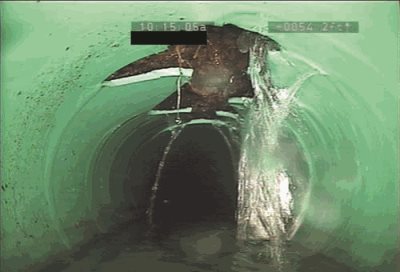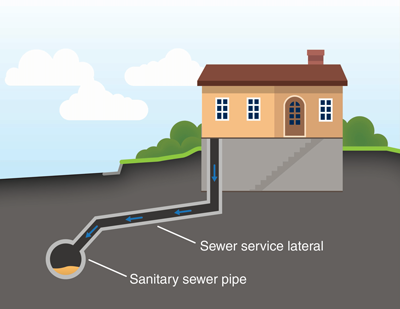
New grant program focuses on reducing private property sources
Sewer infrastructure that conveys wastewater (sewage) to treatment plants is the skeleton underlying development in the region. Water in the system that’s not wastewater creates big problems — like sewer backups into homes or spills into lakes and streams.
For years, the Metropolitan Council has worked with cities connected to the regional wastewater system to help them reduce the amount of stormwater runoff and groundwater that finds its way into the system. Now, the Met Council is developing a grant program that will help property owners pay for work that ensures their sewers convey only wastewater.
I/I: Bane of the regional sewer system
 “In the business, we call clear water that gets into the sanitary sewer system ‘inflow and infiltration’ or ‘I and I’,” said Kyle Colvin, wastewater planning manager in the Met Council’s Environmental Services division. “I/I is the result of groundwater seeping in through cracks or breaks in sewer pipes and from rain leaders, sump pumps, or foundation drains, which are not allowed to be connected to sewer lines by state plumbing code.
“In the business, we call clear water that gets into the sanitary sewer system ‘inflow and infiltration’ or ‘I and I’,” said Kyle Colvin, wastewater planning manager in the Met Council’s Environmental Services division. “I/I is the result of groundwater seeping in through cracks or breaks in sewer pipes and from rain leaders, sump pumps, or foundation drains, which are not allowed to be connected to sewer lines by state plumbing code.
“Water that doesn’t need to be treated as wastewater takes up capacity in the sewer system and can result in spills to the environment and backups into basements. It’s also inefficient and costly to treat water that doesn’t need it,” he said.
Colvin said more than half of the I/I in the sewer system comes from private properties, homes, and businesses in the region.
“Pipes, also known as service laterals, that connect private properties to the wastewater system are the largest source of I/I but receive the least amount of attention in terms of mitigation,” said Colvin. He cites several factors that contribute to deferred maintenance, including lack of awareness and resources to assist property owners.
Task force recommends new grant program
To take on this significant challenge, the Met Council is advancing recommendations of a task force it convened to address the issue of I/I from private properties. The task force recommended, and the Met Council approved, a grant program structured as follows:
- Grants for private property mitigation would be available in communities that the Met Council has identified as having contributed to excessive I/I in the collection system.
- Eligible work for reimbursement from the program includes private lateral repair, disconnection from a foundation drain along with a new sump pump, and lateral cleaning.
- Grant reimbursement will be half of eligible costs up to $5,000. (The average cost to repair a sewer lateral is estimated at $8,000.) Up to $10,000 may be available based on local community-based qualifying equity needs.
“We know I/I is occurring and costing all of us,” said Chad Millner, engineering director for the City of Edina. “We’re investing in our city-owned systems and have worked for many years to nudge private property owners to do the same.
“The City of Edina intends to participate and hopes the program grows in funding and participants to reduce the impacts of I/I on our local and regional system,” said Millner.
As next steps, the Met Council will conduct a public hearing, participate in public outreach and engagement, and accept applications for funding in January 2024.
Funds for the grant program will come from the municipal wastewater charge, a charge communities connected to the regional system pay for the volume of wastewater that flows from their city.
About the private property inflow and infiltration grant program
2023 Private Property Inflow & Infiltration Task Force Report (PDF, June 2023)